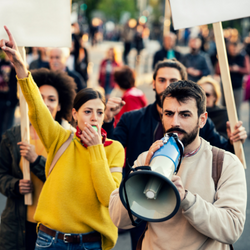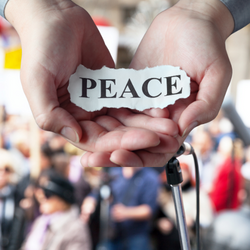Find Your Perfect School
As a form of expression that the first amendment protects, peaceful protests have been around for centuries as a powerful tool that advances political movements and social advocacy. When done right, a peaceful protest can transform students’ lives for the better. They will be able to air out pressing issues that can impact the educational environment.
Additional Info: The Best Colleges Offering Co-op and Internship Programs
Most public colleges and universities support students’ rights to free speech, which often involves organizing peaceful protests and assemblies. This means being able to conduct protests on campus and even in outside areas without having to punish students.
An efficient strategy in place gives demonstrations a chance to succeed. Many students use tactics that can build fruitful campus movements.
Of course, it is still mandatory that whatever assembly or peaceful campus protest students are planning must comply with the school policies and the law in general. This will ensure the safety of everyone involved and the whole campus and surrounding community.
Why Do Students Protest?
Each university has its own shortcomings and issues that can affect students and their learning experience. Beyond academic matters, there are also pressing social and political issues that inspire students to establish a peaceful assembly.
Protests are often the last resort, however. Most of the time, issues are being raised through various other ways, from writing and talking about an issue to reporting, voting, donating, and fundraising. If students want to bring more attention to the issue they are putting forward, they will consider organizing a peaceful protest.
Protests are part and parcel of university life. Some even grew into national movements that led to major changes in the political and socioeconomic aspects. Here are some of the reasons why students protest.
Discrimination
This one is not tolerable and has no room in the modern world. Students are ready to fight any form of oppression as they realize the importance of inclusion in an increasingly multicultural society.
Police Violence
The police have developed such a bad reputation in the last few decades that even students are quite involved when it comes to advancing the causes surrounding this particular issue. Many student protests revolve around ensuring that individuals are treated with dignity by the police.
It is even more relevant since a lot of young people get tangled with the police, sparking popular movements. This somehow includes Black Lives Matter, a huge movement that seeks to highlight racism and discrimination following several incidents of police brutality.
University Policies
Often, university policies impact students’ status and rights within the campus. These changes lead students to go all out and protest in an effort to shift policies for the better. Free access to education is one of the most common policies students wish to advance.
Educational Reforms
There are many reforms when it comes to higher education, especially at the state level. This includes budget and resource allocation. Campus protests have the power to spark conversations and eventually convince policymakers to reconsider the reforms being made.
10 Steps to Plan a Peaceful Protest on Campus
Campus activism is not something that can be organized overnight. For it to succeed, it will require careful planning, in a way that won’t lead to disciplinary action, violation, or punishment. Students will need all the tips they can get to ensure the success of their movement as they defend their free speech rights on campus.
Gather Like-minded People
The core of every peaceful assembly is identifying people with the same causes and motivations and gathering them to form a strong movement. It is important to gather like-minded people who will help out in making a case and maybe determine the number. A peaceful protest may just need eight students to kick off. They should understand why a protest action is necessary. This step may include exchanging contact information with potential student protesters and keeping them updated throughout the majority of the planning process.
Define the Message
Every campus protest needs a goal that students hope to accomplish. This goal needs to be carefully articulated. They should start asking what message they wish to convey and who their target audience will be. They may want to define their goals first. Maybe it is building awareness or building a larger coalition to maintain the momentum of an issue. The protest may aim to be seen and heard by university administrators. Defining these goals will give the following steps a clearer direction.
Decide the Protest Structure
Once they have settled on their goals and identified the participants in the campus protest, students may want to decide the structure of the movement. This is where they determine their strategy. Where are they protesting? For example, it can be in the administration building, classrooms, or other relevant and visible places around the campus. What kind of protest is needed? Is civil disobedience enough or should there be an organized assembly with rallies and marches? Some protests take on the form of walk-outs, vigils, sit-ins, and even choreographed or theatrical expressions.
Do some Research
Protests can be spontaneous, but safe protests take good preparation time, and this involves basic research work on many key areas. Know the authorities to contact in school, especially those who oversee student activities like student protests.
Know the regulations and relevant policies with regard to staging student protests. Know the necessary documents. Find out any organization and a student group in the school that has the same advocacies as you and may be interested to participate, or any community members that may also be able to help plan the protest as well as provide input for this and any other future event.
Get the Timing Right
A key to a safe and effective protest is getting the right timing. Many schools will have one or more designated areas of the campus for student protests and other expressive activities, and it’s up to those planning the protest to pick the best spot for the protest activity. When to do it is just as crucial. It is better to pick a reasonable time when most students are out and about in order for your message to get the widest reach. This includes timing it after school hours to avoid disturbing other students. Protests should not substantially disrupt classes on campus.
All activities done within university premises fall under the watch of university authorities, including protests, which are high-alert activities in terms of campus safety and security. It is important to notify campus police and school administrators, as they are immediately responsible for overseeing the safety of those involved in the protest as well as everyone else. They are also responsible for ensuring that illegal acts aren’t committed, as it is also possible that some who do not belong to the protest movement can stir up trouble.
Get the Word Out
At the heart of every protest is a message, and getting the message across is key. A protest is, in part, a game of numbers, and a point comes when a critical mass of individuals is reached where the message starts to be heard. Getting the word out is thus important even before the protest begins.
On the flip side, however, a protest is not just about quantity but also about quantity. Getting the word out isn’t just about getting a lot of people involved but also getting them properly informed about the core message of the protest. An informed and well-planned protest results in a net gain of new people who understand and are sympathetic to the protest’s core message.
Know Your Rights
Everyone involved in protests falls under the protection of their first amendment rights, as well as other constitutional rights. It is important for those joining protests to know their rights in order to know the limits of their safe actions. After all, even though protests are expressions of one’s rights, it doesn’t mean that others’ rights are violated in the process.
Similarly, it is also important to know your rights in situations where you run into authorities, especially the police. This can be crucial in instances where student protesters get arrested.
Keep it Peaceful
As with any protest, the threat of violence is always present. Many well-meaning movements that started as peaceful protests have descended into chaos, causing damage to public property and to the general public order for a variety of reasons: protesters did not behave accordingly or use the right language, no adequate planning was done by authorities, regulations and manner restrictions weren’t respected, or worse, outside elements who are not sympathetic to the core concerns hijacked the protest to stir up trouble.
Prepare Contingency Plans
As with many things in life, especially activities like protests, something will invariably go wrong. Not only equipment and schedule changes but negative reactions to protests can also exacerbate the threat of violence if not handled properly. A well-planned protest takes into account all possible scenarios and develops a Plan B and Plan C accordingly.
Take a look: The Top Colleges with the Best Student Life
In Conclusion
Student protests have a significant place throughout history, being at the heart of the most significant social movements. Students engage in protests for a range of reasons that are both external and internal to particular universities.
Protests are essential means for freedom of expression, but the freedom to express one’s rights and speak one’s mind comes with the responsibility of respecting the rights of others. Protests should not only convey the core ideas effectively but also be done safely, backed by adequate planning and preparation.
Check this out: The Best Colleges for Undecided Majors



